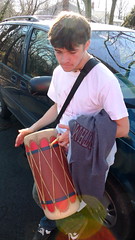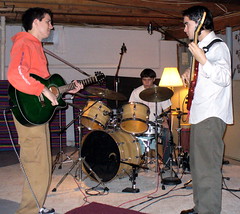 Recording an album has taken a lot more time and money than we anticipated when we first started out… even though we are using a friend’s recording studio (my high school music teacher, Mr. Nuzzo), and we’ve been relatively efficient in using our studio time, we still haven’t quite finished recording the album, and the bills are mounting. Fortunately, we are almost done with the recording phase, with only a few guitars and vocals and other finishing touches left to record. The next step will be mixing all of our tracks.
Recording an album has taken a lot more time and money than we anticipated when we first started out… even though we are using a friend’s recording studio (my high school music teacher, Mr. Nuzzo), and we’ve been relatively efficient in using our studio time, we still haven’t quite finished recording the album, and the bills are mounting. Fortunately, we are almost done with the recording phase, with only a few guitars and vocals and other finishing touches left to record. The next step will be mixing all of our tracks.
First comes the “rough mix”, where we select which of the takes of each track on each song that we have recorded will be used for the final product. This is not as straightforward as it sounds: sometimes we will take the best part of each take and cut and paste them together to form one impossibly good take. The idea is to make sure that you record each section correctly at least once, rather than trying to get the entire song perfect in one take. This method doesn’t work very well if you don’t have the same rhythm track under each take, which is why ideally you want to lay down the rhythm tracks first (drums, bass etc.) and then record everything else later. Naturally, the more times you play the song through to add new instruments, the more studio time you use and the more money you burn. You can also lose some “feeling” when the entire band isn’t recording in the studio together. It’s hard walking the line between recording each instrument separately to approach perfection, and recording everything at once to try to save money and add “soul”. I think we struck a decent compromise with this album, but only time will tell.
 There was also the issue of having too many takes of each track, making it difficult to decide which takes to keep and which to throw away. Brian solved this problem for his guitar solos on this album by wiping and re-recording each guitar solo until he got it exactly the way he wanted it, leaving us with only one take for each solo by the time we got to mixing. That saves us a lot of time when we go to mix, but he may have burned some extra time in recording using that method. For my vocals and Karen’s backup vocals, we laid down a handful of takes and moved on even if no single take was satisfactory, saving time in recording but burning more time in mixing. Ultimately, you have to decide which method is easiest / most efficient for you, it’s not something you can generalize about. (Of course, if you have oodles of money and time, it doesn’t matter which is more efficient, but we’re not at that level.)
There was also the issue of having too many takes of each track, making it difficult to decide which takes to keep and which to throw away. Brian solved this problem for his guitar solos on this album by wiping and re-recording each guitar solo until he got it exactly the way he wanted it, leaving us with only one take for each solo by the time we got to mixing. That saves us a lot of time when we go to mix, but he may have burned some extra time in recording using that method. For my vocals and Karen’s backup vocals, we laid down a handful of takes and moved on even if no single take was satisfactory, saving time in recording but burning more time in mixing. Ultimately, you have to decide which method is easiest / most efficient for you, it’s not something you can generalize about. (Of course, if you have oodles of money and time, it doesn’t matter which is more efficient, but we’re not at that level.)
Next we’ll move deeper into mixing, trying to tweak each track and use various effects to get each song to sound precisely the way we want it to, and editing out slight imperfections. The trick with this stage is not to be absurdly perfectionist, setting time limits and knowing when to walk away from a song that is “good enough”, otherwise the album will never get done. We’ll do our best 🙂
After that, if we think it’s worth cleaning up the album to top-40 radio quality, we’ll have to get someone to master the album, polishing our sound to a shiny finish. We’ll see how the album is sounding by then, and how much that process will cost…
I (Nelson) have relocated to southern California for the rest of the semester, so progress on the album will be slow until I return in May, but we’ll start seriously mixing in May, and we hope to release the album to you wonderful people sometime this summer.

